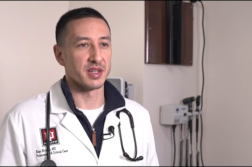PHOENIX, Ariz. (Ivanhoe Newswire) — University of Arizona researchers believe they may have found the next best testing ground for their work … in the grocery store. Could spinach be the answer? Sounds like science fiction, but it’s the latest convergence of biology and technology.
In a lab in Phoenix, scientists are turning spinach leaves into high-tech scaffolding for tissue engineering and disease research.
“The scaffold, the plant can be used to grow the cells, but also now all the veins and the stem of the leaf could be used as the vascular system,” explained Frederic Zenhausern, PhD, MBA, Professor and Director, Center for Applied Nanobioscience and Medicine at University of Arizona
Frederic Zenhausern’s team is creating a 3D leaf platform. First, they use detergents and a flushing system to decellularize the leaf.
“You need to remove the cells from the plant, be sure that there is no residue or component of the plant, and then be able to bring the human component to those scaffolds.” Said Zenhausern.
Ken Knox, MD, Professor of Medicine and Immunobiology at University of Arizona College of Medicine, Phoenix, and Research Director, Lung Institute at Banner – University Medical Center, Phoenix sees similarities between leaf veins and lungs. Now, he’s on the team that will eventually put lung cells on the leaf scaffold.
Dr. Knox said, “So our hope would be that we have this model that serves as a platform that we could take a patient’s blood and test it in concert with the models such that it’s very specific to that patient’s responses.”
That could be good news for Jim Franks, who has sarcoidosis. It causes inflammation in the lungs and is one of the conditions Dr. Knox is studying.
“it’s really the dry cough and short of breath. And it does kick in if I do something really strenuous.” Franks shared.
He loves the possibility of doctors finding treatments with the lung on a leaf.
“I like the idea that future generations that have this disease might, may have different treatments alternatives.” Said Franks.
Dr. Knox says the team will have figured out how to consistently reproduce the leaf model in two years. At that time, he hopes to start testing therapies in their lung on a leaf.
Contributors to this news report include: Wendy Chioji, Field Producer; Bruce Maniscalco, Videographer; Cyndy McGrath, Supervising Producer; Hayley Hudson, Assistant Producer; Dave Harrison, Editor.
To receive a free weekly e-mail on Medical Breakthroughs from Ivanhoe, sign up at: http://www.ivanhoe.com/ftk
MEDICAL BREAKTHROUGHS
RESEARCH SUMMARY
TOPIC: LUNG ON A LEAF
REPORT: MB #4480
SARCOIDOSIS: Sarcoidosis consists of the growth of tiny collections of inflammatory cells in different parts of the body, including but not limited to the lungs, skin, and eyes. It is believed this is caused by inhalation of an unknown substance, and there is no current cure; however, most people respond well to treatment options. Signs and symptoms may vary depending where the growth occurs, and while some develop slowly and gradually, some may appear suddenly and disappear just as quickly. Many people show no symptoms and it is only discovered via chest X-ray for another reason. General symptoms may include fever, fatigue, swollen lymph nodes, and weight loss. Lung symptoms may include issues with breathing such as shortness of breath, wheezing, chest pains, or even a persistent dry cough.
(Source: https://www.mayoclinic.org/diseases-conditions/sarcoidosis/symptoms-causes/syc-20350358)
TREATMENTS: While there is no cure for sarcoidosis, over half of the cases go away on their own. Treatment is only necessary if a patient is showing significant signs and symptoms. If they are severe or organ function is threatened, patients can be treated with medications. These include things like corticosteroids; powerful anti-inflammatory drugs and medications that suppress the immune system like Trexall, Azasan, or Imuran. Hydroxychloroquine may be helpful for skin reactions and elevated blood-calcium levels. Or possibly even tumor necrosis factor-alpha inhibitors that are commonly used to treat inflammation associated with rheumatoid arthritis. Organ transplant surgery may be considered if the disease has seriously caused damage to the heart, lungs, or liver.
(Source: https://www.mayoclinic.org/diseases-conditions/sarcoidosis/diagnosis-treatment/drc-20350363)
NEW TECHNOLOGY: Researchers at the University of Arizona are looking at new ways of generating technology, specifically models capable of growing cells into a formation that matches tumor models in patients. These models can then eventually be used to test treatment options and conduct research on different kinds of diseases, including, but not limited to, lung diseases and lung cancer. They have found that spinach leaves contain the vasculature needed to accurately represent some of the muscle tissue the researchers need to connect and study these kinds of tissues. The challenge is decellularizing the model, essentially removing all cells from the plant and replacing them with the human components needed to create these cell models. Ultimately, these models and this invitro system will speed up the process of studying and testing therapies for different kinds of diseases, including lung cancer.
(Source: Dr. Frederic Zenhausern)
FOR MORE INFORMATION ON THIS REPORT, PLEASE CONTACT:
Jean Spinelli
520-626-2531
If this story or any other Ivanhoe story has impacted your life or prompted you or someone you know to seek or change treatments, please let us know by contacting Marjorie Bekaert Thomas at mthomas@ivanhoe.com




